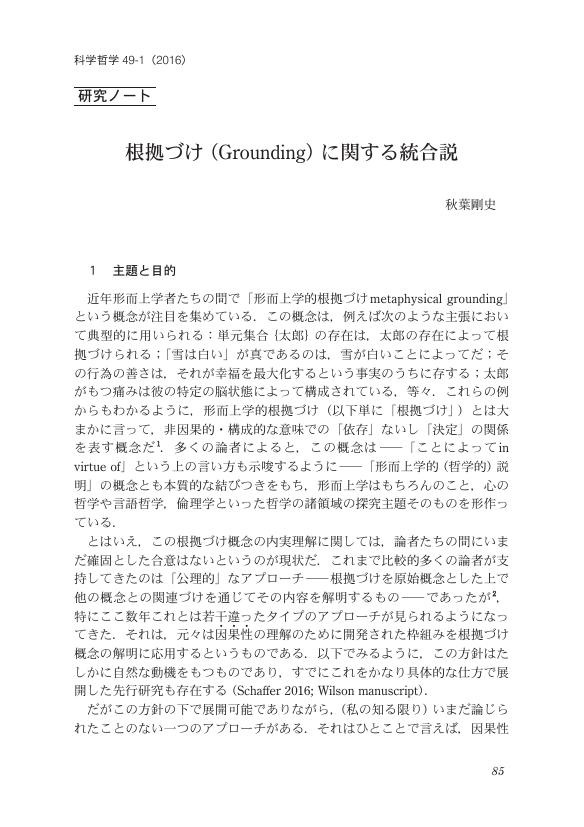4 0 0 0 OA 数字が見やすいUDフォントと高齢者や視覚障がい者に配慮したカレンダーの開発
- 著者
- 矢口 博之 竹下 直幸 中本 和宏 水野 昭 八杉 淳一
- 出版者
- 一般社団法人 日本デザイン学会
- 雑誌
- デザイン学研究作品集 (ISSN:13418475)
- 巻号頁・発行日
- vol.21, no.1, pp.1_38-1_41, 2016-02-01 (Released:2016-04-19)
- 参考文献数
- 4
近年、ユニバーサルデザイン(以下UD)は多くの分野に広がり始めている。各種メディアや情報システムをはじめとするコミュニケーション分野においてもUDフォント、カラーユニバーサルデザインなどUDの考え方が普及してきている。本作品では、見やすさが実証されたUDフォント「みんなの文字」を基に、カレンダー専用フォントを作成し、高齢者や視覚障がい者にも見やすい暦をデザインした。数字自体の視認性を高め、暦としての機能性やユーザビリティを担保した上で、認知科学を応用して色だけに頼らない休日、祝日の表現などにより、カラーユニバーサルデザインへの対応も考慮した。開発に際し、試作品と他社製品を対象とした読み取りタスクによる視認性評価実験を行ったところ、本カレンダーの試作品が最も視認性が高いとの結果が得られた。
4 0 0 0 OA 日本の戦争指導におけるビルマ戦線 : インパール作戦を中心に
- 著者
- 荒川憲一
- 出版者
- 防衛省
- 雑誌
- 戦争史研究国際フォーラム報告書
- 巻号頁・発行日
- vol.第1回, 2003-03
4 0 0 0 OA アイヌ語の数詞再考 : 二十進法における下方算法から上方算法への切り替え
- 著者
- 落合 いずみ
- 出版者
- 日本北方言語学会
- 雑誌
- 北方言語研究 (ISSN:21857121)
- 巻号頁・発行日
- vol.11, pp.99-121, 2021-03-20
This paper reconstructs the vigesimal system and the numerals based on that system in Post-Proto-Ainu by comparing three dialects of Ainu: the Hokkaido dialect, the Sakhalin dialect, and the Kuril dialect. In the Ainu vigesimal system, multiples of 20 are indicated by hot, the word for “20,” whose proto form is reconstructed as *gOt. This paper analyzes the structures of the numerals between adjacent multiples of 20, such as the numerals from 21 to 39, from 41 to 59, and from 61 to 79. In the vigesimal system, each interval comprises 19 units. This paper proposes that the former nine units and the latter ten units show different structures. The units in the interval (e.g., 21 to 39) can either be expressed by the lower multiple of 20 (i.e., 20) or the higher multiple of 20 (i.e., 40). Expressing the units by using the lower multiple of 20 is called undercounting (or additive counting); expressing the units by using the higher multiple of 20 is called overcounting. This paper claims that the former 9 units (e.g., 21 to 29) use undercounting, whereas the latter 10 units (e.g., 30 to 39) use overcounting. The undercounted numeral 21 is expressed as “1 more than 20.” The overcounted numeral 30 is expressed as “10 goes toward 40,” and 31 as “11 goes toward 40.” In previous studies, the latter ten units have been explained by different counting methods. The odd multiples of ten (e.g., 30, 50, and 70) have been explained by subtraction (i.e., 40−10, 60−10, and 80−10, respectively). The following numerals (e.g., 31, 51, and 71) have been explained by a further addition of digits (i.e., 40−10+1, 60−10+1, and 80−10+1, respectively). This paper treats these ten units in a uniform manner by proposing an overcounting numeral system for them.
4 0 0 0 OA 張元済の最初の訪日と市島春城
- 著者
- 稲岡 勝
- 出版者
- 日本出版学会
- 雑誌
- 出版研究 (ISSN:03853659)
- 巻号頁・発行日
- vol.42, pp.167-180, 2012-03-20 (Released:2019-03-31)
- 参考文献数
- 10
清末民初の大変動時代に,上海の商務印書館を東洋一の大出版社に導いた文人が張元済 (1867–1959) である.この偉大な編訳人は1908年,静養のため初めて日本を訪れ多くの見聞を深めた.そのうちで日本の書誌学者たちとの交流の一齣を,日中の史料を用いて明らかにする.
- 著者
- 山口 隆男
- 出版者
- 日本甲殻類学会
- 雑誌
- CANCER (ISSN:09181989)
- 巻号頁・発行日
- vol.20, pp.99-104, 2011-08-01 (Released:2017-07-05)
- 参考文献数
- 17
4 0 0 0 OA 海上輸送力の戦い : 日本の通商破壊戦を中心に
4 0 0 0 OA オッカムの概念論 フィクトゥム説からインテレクチオ説への変換
- 著者
- 渋谷 克美
- 出版者
- 日本哲学会
- 雑誌
- 哲学 (ISSN:03873358)
- 巻号頁・発行日
- vol.1991, no.41, pp.90-101, 1991-04-01 (Released:2009-07-23)
4 0 0 0 OA イチョウの属名Ginkgoの由来に関する新説の検討
- 著者
- 柴田 松太郎
- 出版者
- 地学団体研究会
- 雑誌
- 地学教育と科学運動 (ISSN:03893766)
- 巻号頁・発行日
- vol.33, pp.45-50, 2000-02-25 (Released:2018-03-29)
- 参考文献数
- 22
4 0 0 0 OA メディカルチェックで調査した大学硬式野球部員のUCL損傷の特徴
- 著者
- 柘植 弘光 原 友紀 道信 龍平 池田 和大 十時 靖和 井汲 彰 小川 健 西浦 康正 吉井 雄一 山崎 正志
- 出版者
- 日本肘関節学会
- 雑誌
- 日本肘関節学会雑誌 (ISSN:13497324)
- 巻号頁・発行日
- vol.28, no.2, pp.105-107, 2021 (Released:2021-11-26)
- 参考文献数
- 6
目的:大学硬式野球部員59名にメディカルチェックを実施し,肘スポーツ障害の特徴について検討した.方法:問診票で現在の症状の有無や既往歴を確認し,検診では上下肢体幹の可動域,筋力に加え,肩肘について圧痛,moving valgus test,尺骨神経の診察などを行った.55例に肘のMRIを実施し,UCL損傷を調査した.MRIでUCL損傷ありと判断された選手の肘内側障害や肩障害にについて解析した.結果:肘のMRIで70.1%にUCL損傷を認め,そのうち69.2%は無症状であった.肘内側症状のあるUCL損傷群は,それ以外の選手群と比較して肩外旋可動域の制限や肩甲下筋筋力の低下がある傾向があり,肩のインピンジメント徴候が多い傾向があった.考察:大学野球選手には無症候性UCL損傷所見が多くみられた.また有症状のUCL損傷群は肩の不調を併発する傾向がみられた.
4 0 0 0 OA 福島後の原発裁判と司法の役割
- 著者
- 吉田 克己
- 出版者
- 一般社団法人 日本原子力学会
- 雑誌
- 日本原子力学会誌ATOMOΣ (ISSN:18822606)
- 巻号頁・発行日
- vol.59, no.5, pp.273-277, 2017 (Released:2020-02-19)
- 参考文献数
- 5
原発設置認可の取消しやその建設・運転の差止めを求める原発訴訟は,福島第一原発事故前には,若干の例外を除いてすべて住民敗訴の結果に終わっていた。福島後は,大飯原発に関する福井地裁の差止認容判決や高浜原発に関する大津地裁の差止認容仮処分決定など,注目すべき住民勝訴の裁判例が出るようになっている。判断を導く論理にも,従前とは異なる新たなものが見出される。これらを通じて,従来は基本的には行政の一元的チェックに委ねられていた原発の安全性確保について,司法も加えた多重かつ多元的なチェック態勢の構築が展望される。
4 0 0 0 OA 根拠づけ(Grounding)に関する統合説
- 著者
- 秋葉 剛史
- 出版者
- The Philosophy of Science Society, Japan
- 雑誌
- 科学哲学 (ISSN:02893428)
- 巻号頁・発行日
- vol.49, no.1, pp.85-90, 2016-07-31 (Released:2016-11-10)
- 参考文献数
- 11
4 0 0 0 生産技術
- 著者
- 生産技術協会 [編]
- 出版者
- 生産技術協会
- 巻号頁・発行日
- vol.23(1), no.252, 1968-01
4 0 0 0 生産技術
- 著者
- 生産技術協会 [編]
- 出版者
- 生産技術協会
- 巻号頁・発行日
- vol.8(6), no.77, 1953-06
4 0 0 0 OA 理念(idea)としてのヨーロッパ
- 著者
- 村田 奈々子
- 出版者
- 法政大学言語・文化センター
- 雑誌
- 言語と文化 = 言語と文化 (ISSN:13494686)
- 巻号頁・発行日
- pp.243-267, 2015-01
4 0 0 0 OA 諏訪明神縁起の研究 : 諏訪信仰の神話世界 [論文内容及び審査の要旨]
- 著者
- 間枝 遼太郎
- 巻号頁・発行日
- 2022-03-24
北海道大学. 博士(文学)
- 著者
- 浅田 健太朗
- 出版者
- 日本音声学会
- 雑誌
- 音声研究 (ISSN:13428675)
- 巻号頁・発行日
- vol.8, no.2, pp.35-45, 2004-08-31 (Released:2017-08-31)
This paper describes a change in the degree of the independence of the postpositional mora by taking notice of the position of kana in the scores of shomyo, Japanese Buddhist chants. An investigation into the scores of the Nanzan-shin School, the Soo-in School and the Tendai School revealed that the postpositional mora acquired its independence as a unit of syllabication during the Medieval Japanese and Early Modern Japanese periods.
4 0 0 0 OA トルーマン政権におけるトルコの位置づけに関する一考察 : 「中東」から「ヨーロッパ」へ?
- 著者
- 佐藤 真千子
- 出版者
- 静岡県立大学国際関係学部
- 雑誌
- 国際関係・比較文化研究 (ISSN:13481231)
- 巻号頁・発行日
- vol.5, no.2, pp.401-430, 2007-03-01



